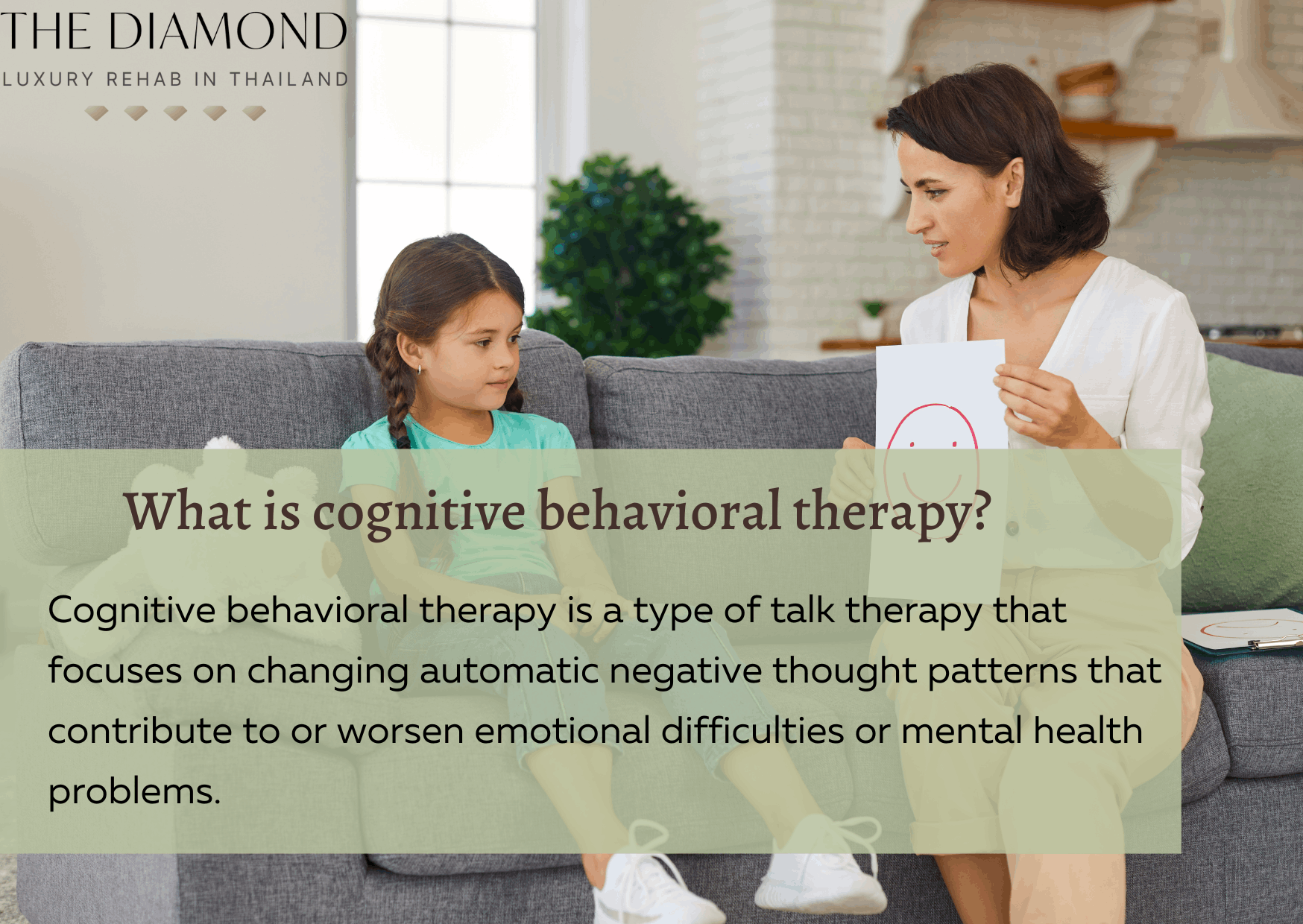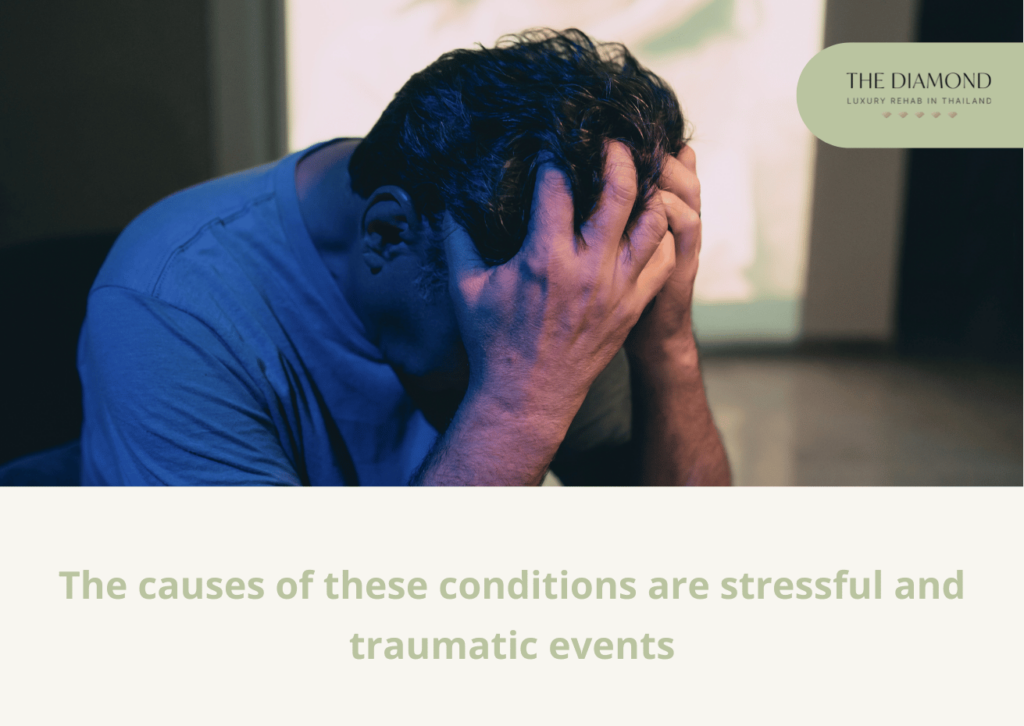9 cognitive behavioral therapy techniques
Table of content
- 1. Restructuring or reframing of the mind
- 2. Assisted exploration
- 3. Exposure treatment
- 4. Journaling and keeping notes
- 5. Activating behavior and scheduling activities
- 6. Experiments with behavior
- 7. Techniques for reducing tension and anxiety
- 8. Acting out
- 9. Incremental approximation
- What is cognitive behavioral therapy?

Cognitive behavioral therapy (CBT) is a type of psychotherapy that helps manage problems by changing thinking and behavior patterns. This type of talk therapy teaches that destructive, irrational, and disturbing thought patterns negatively affect moods and behaviors.
They contribute to various mental health conditions, including depression, anxiety, addiction, and others. During CBT sessions, patients learn to identify these thoughts and replace them with realistic and more positive alternatives that ultimately lead to improvements in moods, emotions, and behaviors.
The main benefits of CBT include developing healthier thought patterns, better coping mechanisms, and improved skills necessary for functioning in daily life.
Therapists choose from a wide range of CBT techniques to help their patients. Cognitive behavioral therapy techniques are listed below:
- Restructuring or reframing the mind
- Assisted exploration
- Exposure treatment
- Journaling and keeping notes
- Activating behavior and scheduling activities
- Experiments with behavior
- Techniques for reducing tension and anxiety
- Acting out
- Incremental approximation
1. Restructuring or reframing of the mind
Restructuring or reframing of the mind is defined as a therapeutic process that helps patients discover, challenge, and replace or modify irrational or negative thoughts. Cognitive restructuring is considered the cornerstone of CBT.
This technique has a simple mechanism of action. It works by deconstructing unhelpful thoughts and helping rebuild them in a more accurate and balanced manner. Cognitive restructuring or reframing works through several techniques, such as self-monitoring, questioning one’s assumptions, gathering evidence to challenge the current thought patterns, generating alternatives, and performing cost-benefit analysis. The latter involves considering both advantages and disadvantages of maintaining a specific cognitive distortion.
Restructuring or reframing the mind is based on the notion that people often experience cognitive distortions. In simple words, cognitive distortion is a thought pattern that generates an unhealthy or distorted view of reality. Cognitive distortions often lead to serious mental health problems such as anxiety, depression, and self-defeating behaviors.
According to a 2017 paper by Constantina Panourgia and Amanda Comoretto published in the journal Stress and Health, there are seven types of cognitive distortions. These include dichotomous thinking (black-and-white thinking), self-reference, predicting without sufficient evidence, personalization, catastrophizing, overgeneralization, and selective abstraction.
The greatest importance of cognitive restructuring and reframing is that patients learn to notice these maladaptive behaviors as they happen. That way, it becomes easier to manage symptoms of depression, anxiety, or other mental health disorders.
Advantages of restructuring or reframing the mind range from lower stress and anxiety levels to stronger communication skills, healthier relationships, rebuilt confidence and self-esteem, and replacing unhealthy coping mechanisms such as substance abuse.
2. Assisted exploration
Assisted exploration, otherwise known as guided discovery and Socratic questioning, is a process during which the counselor or therapist helps a patient reflect on the way they process information. It is based on a series of questions allowing information to be brought into the patient’s awareness. The patients are encouraged to discover things for themselves.
Assisted exploration works through four stages. During the first phase, a therapist asks informal questions. The second phase involves the therapist listening attentively and reflecting back, while the third stage is about summarizing newly acquired information. The fourth stage is reserved for asking analytic or synthesizing questions to apply the new info to the patient’s original thought or problem.
The importance of assisted exploration is that it helps patients develop alternative interpretations of their problems or thoughts. Assisted exploration relies on collaboration that aids therapeutic relationships and helps a patient feel respected, valued, and accepted.
During questioning, patients consider options and solutions they haven’t considered before. As a result, they start evaluating their beliefs and thoughts more objectively. Not only does a patient think about a problem at hand, but possible solutions. Since they start evaluating and analyzing, patients cope with disrupting and destructive thoughts more effectively. This helps manage their mental health problem.
The main benefit of assisted exploration is the opportunity to perceive information in different ways and thereby access a range of choices in life. In other words, patients see their life through different lenses.
3. Exposure treatment
Exposure treatment, or exposure therapy, is a type of behavioral therapy that involves exposing a patient to the source of phobia or anxiety in a dosed and graded manner so they’re able to overcome their fears. This CBT technique is mainly used for patients with phobia and post-traumatic stress disorder (PTSD).
Exposure treatment works by breaking the pattern of fear and avoidance. The patient is – under the therapist’s guidance – exposed to the stimulus that causes fear. The therapy is performed in a safe environment that poses no danger to a patient.
According to a 2017 article titled, “What Is Exposure Therapy?” published in The American Psychological Association’s Clinical Practice Guideline for the Treatment of Posttraumatic Stress Disorder stated different types of exposure treatment, such as in vivo exposure (facing fear in real life), imaginal exposure (fear imagined vividly), virtual reality exposure (using VR technology), and interoceptive exposure (triggers physical sensation to demonstrate the object or situation is harmless, even if feared).
The importance of this technique is that gradual exposure to the source of fear or anxiety helps patients create realistic beliefs about the stimulus. At the same time, the therapy helps unlearn negative associations with a feared situation or object.
Through habituation, patients decrease their reaction to the source of their fear or phobia. In addition, exposure treatment improves self-efficacy by showing patients that it is possible to overcome or manage their anxiety.
Benefits of exposure treatment include reduced sensitivity to distressing situations, decreased fear, increased ability to tolerate fear, lower anxiety, better social skills, and improved functioning and mental stability.
4. Journaling and keeping notes

Journaling is defined as the practice of keeping notes of thoughts, feelings, or insights. Cognitive journaling is a technique that enables patients to observe and release the thought patterns they have on a daily basis.
This technique works by helping patients get in touch with their thoughts. The therapist is going to ask a patient to list negative thoughts they’ve been having between sessions. Next to negative thoughts, it’s necessary to write all the positive or more realistic alternatives patients have instead.
The greatest importance of journaling and keeping notes is that it allows patients to track their progress. It’s easier to see how far they’ve gone and how much they have accomplished so far when they take a look at the journal or notes they’ve written.
A 2022 paper by Sohal et al., from Family Medicine and Community Health reported that journaling is a practical, low-cost strategy to manage common mental health symptoms.
The most significant benefits of journaling and keeping notes include better mood and psychological well-being, fewer depressive episodes, lower stress and anxiety, and better adherence to the treatment of an underlying mental health problem.
5. Activating behavior and scheduling activities
Activating behavior and scheduling activities is a therapeutic technique based on the notion that regularly engaging in pleasant activities helps relieve symptoms of depression and improve mood. Otherwise known as activity scheduling and behavioral activation, this technique is used on its own or combined with other CBT approaches.
Activity scheduling works by giving patients something to look forward to. The act of scheduling or planning a specific activity improves mood. Keep in mind this technique puts a strong emphasis on actively planning periods of time dedicated to promoting personal goals and self-values. That specific activity enriches a patient’s physical and mental well-being.
In fact, a study by Riebe et al., published in the December 2012 issue of the International Journal of Geriatric Psychiatry found that clinically substantial improvements in depression and self-reported activity engagement at the 12-month mark were both strongly correlated with structured activity scheduling during treatment.
The importance of this technique is that it helps establish good and healthy habits while providing an opportunity for patients to put what they’ve learned during CBT sessions into practice.
Advantages of activating behavior and scheduling activities include an improved focus on increasing activities a patient enjoys, a sense of achievement, better confidence, and stronger coping skills and mechanisms. Like other techniques, therapists usually combine activity schedules with other approaches.
6. Experiments with behavior
Experiments with behavior are planned experimental activities whose main goal is to test the validity of a belief. Behavioral experiments are among the most powerful CBT techniques. It is mostly used for anxiety disorders characterized by catastrophic thinking.
As an information-gathering exercise, behavioral experiments work by evaluating the accuracy of a patient’s beliefs about themselves, other people, and the world in general. Therapists use this technique to examine fresh, more flexible beliefs, according to an article titled, “Behavioral Experiment” from Psychology Tools.
For example, before starting the activity that usually causes anxiety, the patient is asked to predict the outcome. Later, the therapist and patient discuss whether the prediction came true or not.
The importance of this technique is that, with time, a patient starts realizing the predicted catastrophe is unlikely to happen. This helps manage their symptoms and allows them to handle their mental health problem more effectively.
The benefits of behavioral experiments revolve around improved rationalization of thought patterns, lower anxiety, better mood, increased self-esteem, and improved thinking. Additionally, patients learn to feel and experience new beliefs as well as to assimilate them on emotional and intellectual levels.
7. Techniques for reducing tension and anxiety
Techniques for reducing tension and anxiety are different practices that promote relaxation and thereby help patients relieve their symptoms. Various relaxation techniques are available such as deep breathing exercises, imagery, and muscle relaxation.
These techniques work by lowering stress and increasing a patient’s sense of control. That’s why they are important for the more effective management of social anxiety, phobia, and other stressors.
People with mental health problems such as anxiety experience intense symptoms that don’t allow them to react to certain stimuli in a healthy manner. The relaxation techniques allow a person to calm their mind within a few seconds and thereby react to the stimuli more effectively. That’s the greatest importance of this technique.
Benefits of relaxation techniques include reduction of impulsive behaviors, decreased worry, reduced sleep problems, and improved quality of life.
8. Acting out
Acting out, or role-playing, is a technique that allows a patient to practice new behaviors. It helps patients work through different behaviors in potentially difficult situations.
Role-playing works in a simple manner. Therapists and patients practice specific scenarios and have different roles, like in a school play. For instance, if a patient has anxiety before a big job interview, the therapist assumes the role of the interviewer so the patient is able to practice.
This technique works because a therapist gets to analyze the patient’s responses after the mock scene. Then, they discuss with the patient whether there’s something they need to change or do differently.
Role-playing is important because it subtly pushes a patient out of their comfort zone. It additionally desensitizes the patient so that they’re less fearful of certain situations.
The main advantage of role-playing is its versatility. It is used for practicing social skills, improving problem-solving skills, assertiveness training, better communication skills, and gaining confidence and familiarity in otherwise dreadful situations.
9. Incremental approximation
Incremental approximation, or successive approximation, is a cognitive behavioral therapy technique that helps people tackle overwhelming or difficult goals. Otherwise known as shaping, it works for people who experience difficulty completing tasks either because they are overwhelming or due to a lack of familiarity with the tasks.
The successive approximation works by taking those big tasks and breaking them down into smaller increments. These smaller increments are usually simpler and easily achievable. Each successive step builds upon the previous steps. As a result, the patient’s confidence keeps improving.
The importance of incremental approximation is that it gives patients a sense of accomplishment. Every time they complete a small goal, they feel accomplished and confident enough to take on the other, then the other, and so on. Eventually, a patient stops considering certain tasks overwhelming, which improves symptoms of their anxiety or other mental health issues.
The advantage of incremental approximation is that it helps change maladaptive thoughts that prevent patients from functioning in everyday life.
What is cognitive behavioral therapy?

Cognitive behavioral therapy is a type of talk therapy that focuses on changing automatic negative thought patterns that contribute to or worsen emotional difficulties or mental health problems. Automatic negative thoughts have a detrimental impact on our feelings, moods, and behaviors.
As a combination of cognitive therapy and behavior therapy, CBT helps patients identify maladaptive or faulty patterns of thinking, behavior, or emotional response and then substitute them with more desirable alternatives.
American psychiatrist Aaron T. Beck developed cognitive-behavioral therapy in the 1960s. Dr Beck noticed his patients with depression often described thoughts that lacked validity. He found their thinking patterns exhibited cognitive distortions.
This led Dr. Beck to conclude that depression is not just a mood disorder but a cognitive problem as well. After that, he outlined a cognitive theory of depression and developed talk therapy that helped patients identify cognitive distortions.
What is the importance of CBT techniques?
The importance of CBT techniques is that they help patients overcome obstacles created by distorted thoughts and beliefs. This is particularly important because distorted thoughts lead to negative emotions and problematic behaviors, which contribute to or cause mental health problems.
According to the Mayo Clinic, CBT techniques help manage symptoms of a mental illness and prevent relapse. These techniques are effective in treating mental illnesses when medications don’t work. Additionally, CBT teaches coping techniques and helps patients identify ways to manage their emotions. Other reasons CBT techniques are important include coping with loss or grief, overcoming trauma, and resolving relationship conflicts or improving communication skills.
How do cognitive behavioral therapy techniques work?

The cognitive-behavioral therapy techniques work by focusing on the present thoughts and beliefs, whereas other types of psychotherapy look into the past. These techniques emphasize the importance of identifying, challenging, and changing how patients view a specific situation.
More precisely, cognitive-behavioral techniques strive to transform any way of behaving and thinking that affects a person’s functioning and ability to live their life. To do so, it’s necessary to identify negative perceptions that are affecting a patient’s behavior. Therapist relies on different techniques depending on the mental health disorder, the intensity of symptoms, and the specific needs of each patient.
Distorted thought patterns lead to problems such as jumping to conclusions, seeing situations as catastrophic, and seeing things as good or bad with nothing in between. With CBT techniques, patients are taught to challenge automatic thoughts and compare them with reality. This leads to reduced distress. Patients get an opportunity to take action or make decisions that are more likely to benefit them in the long run.
What should you expect from cognitive behavioral therapy?
You should expect cognitive-behavioral therapy to be performed in individual therapy sessions, but sometimes group therapy is also necessary. You can also expect to learn about your mental health condition and also get educated about relaxation techniques such as resilience, coping, deep breathing, assertiveness, and stress management.
During the first session, the therapist will gather information regarding current and past emotional and physical health. The main purpose of these questions is to get a deeper understanding of a patient’s situation. The first session is the longest and may last up to 60 minutes, whereas subsequent sessions last around 45 minutes.
During subsequent sessions, the therapist encourages the patient to talk about their thoughts and feelings. The emphasis is on a healthy therapeutic relationship, which is why a therapist doesn’t judge or criticize a patient. The therapist uses a goal-oriented approach to focus on specific problems.
Patients receive homework at the end of each session. The main purpose of homework is to practice skills and everything a patient learned during the session and write about it.
You can expect that the therapist’s approach depends on the specific situation. For that reason, they may use CBT alone or combine it with other types of therapies. The exact number of sessions varies from one person to another and depends on their mental health, but it’s usually five to 20 sessions.
Where can cognitive behavioral therapy be used?
Cognitive-behavioral therapy is used for the management of a wide range of mental health problems and issues affecting a person’s everyday functioning. The most common uses are listed below:
- Depression
- Anxiety disorders
- Alcohol and drug use problems
- Marital problems
- Eating disorders
- Severe mental illness
1. Depression

Depression is a serious mental health disorder that negatively affects how a person feels, thinks, and acts. It is not a weakness that a person can “snap out” of easily, but a disease that requires a well-structured treatment program.
Symptoms of depression occur in episodes that are usually indicated by feelings of sadness and hopelessness, anger and irritability, loss of interest, sleep disturbances, fatigue, appetite changes, anxiety, restlessness, slowed thinking, feelings of worthlessness, trouble concentrating, suicidal thoughts and tendencies, and unexplained physical problems like headaches.
Although the exact cause of depression is unknown, several factors could play a role in its development. Potential causes of depression include physical changes in the brain, low serotonin levels, hormonal imbalances, and inherited traits.
Risk factors that make a person more susceptible to depression include some personality traits like low self-esteem, personal history of mental health problems, family history of depression and mental health illness, addiction, chronic illnesses, and traumatic or stressful events.
Short-term effects of depression are continuous low mood, sadness, and social withdrawal. On the other hand, long-term effects of depression include weight gain or obesity, pain or physical illness, addiction suicidal ideation, self-harm such as cutting, relationship difficulties, family conflicts, and problems at school or work.
Treatment for depression usually revolves around a combination of medications and psychotherapy. The most commonly prescribed antidepressants are selective serotonin reuptake inhibitors (SSRIs), serotonin-norepinephrine reuptake inhibitors (SNRIs), atypical antidepressants, tricyclic antidepressants, and monoamine oxidase inhibitors. The main psychotherapy approach for the treatment of depression is cognitive-behavioral therapy.
2. Anxiety disorders

Anxiety disorders are indicated by intense, excessive, and persistent worry or fear about specific situations. The most significant anxiety disorders are agoraphobia, generalized anxiety disorder, panic disorder, selective mutism, social phobia, specific phobias, and others.
The symptoms depend on the specific anxiety disorder. In most cases, patients experience tension, nervousness, restlessness, impending doom feeling, hyperventilation, increased heart rate, and sweating or trembling. Other symptoms include fatigue, difficulty sleeping and concentrating, gastrointestinal problems, difficulty controlling worry, and a strong urge to avoid things that cause anxiety.
While the causes of anxiety disorders are poorly understood, traumatic events are likely to trigger them. Some people have a genetic predisposition as well, Mayo Clinic confirms. Some chronic medical conditions can also contribute to the development of anxiety.
Risk factors for anxiety disorders include trauma, illness-related stress, unmanaged stress, family history of anxiety, drug or alcohol abuse, and other mental health disorders.
The short-term effects of anxiety are heart palpitations, upset stomach, muscle aches, and dizziness. Long-term effects include depression, poor quality of life, addiction, insomnia, digestive problems, headaches, social isolation, and suicide.
Like depression, anxiety disorders are primarily treated with medications and psychotherapy. The most common psychotherapy approach is CBT.
3. Alcohol and drug use problems

Alcohol and drug use problems refer to substance use disorders or addiction i.e. compulsive need to keep using some substance despite the harms it causes.
The main symptoms of alcohol and drug use problems are developing tolerance quickly and needing to use higher amounts for the same effects, strong cravings, and unsuccessful attempts to stop. People also experience withdrawal symptoms when not using alcohol and drugs, spending a lot of time and money on buying, using, and recovering from these substances. Patients with substance abuse lose interest in activities they once enjoyed and engage in risky behaviors just to obtain alcohol or drugs.
The causes of these problems are genetics and the environment, such as family beliefs and attitudes, peer pressure, and early exposure to these substances.
Risk factors for alcohol and drug use problems include a family history of addiction, peer pressure, lack of family involvement, having other mental health disorders, early use, and taking highly addictive drugs.
Short-term effects of alcohol and drug use problems include impaired coordination, fast heartbeat, dizziness, nausea and/or vomiting, increased wakefulness, reduced appetite, increased breathing, erratic or violent behavior, slurred speech, dry mouth, and others, according to Medical News Today.
Long-term effects include psychotic behaviors, seizures, organ failure, overdose, infectious diseases, higher risk of accidents, family problems, work problems, financial or legal difficulties, and death.
Treatment for alcohol and drug use problems includes detox and residential and outpatient programs. The programs involve therapy sessions, mainly CBT, to help patients recover in a supportive, supervised, and encouraging environment.
4. Marital problems

Marital problems are issues that two people face in the marriage due to a breach of domestic anticipation.
Common symptoms of marital problems are sleeping in separate bedrooms, a significant decrease in sexual contact, secrets, resentments, and unsatisfactory or nonexistent communication between two people. Marital problems also include a lot of arguing between spouses.
Common causes of marital problems are lack of intimacy, money, change in appearance, chores, poor communication, fertility struggles, infidelity, inconsistent religious beliefs, predictability, and trauma.
The main risk factor for marital problems is a tendency to avoid open and honest conversations with other people to resolve problems. Instead, problems are swept under a rug. Secretive personality traits may also increase the risk.
The short-term effects of marital problems are an uncomfortable and toxic environment filled with resentment and fights. Long-term effects of marital problems are divorce, custody battles, and problems with other family members.
The main treatment approach for marital problems is cognitive-behavioral therapy. Held in a couple’s setting, this therapy helps two people connect and communicate more effectively.
5. Eating disorders

Eating disorders are defined as abnormal eating behaviors that negatively affect a person’s health, emotions, and functioning in daily life. The most common eating disorders are bulimia nervosa, anorexia nervosa, and binge-eating disorder.
The symptoms are specific for each disorder. Patients with anorexia have abnormally low body weight, intense fear of weight gain, and a distorted perception of weight and shape. They may avoid eating and severely restrict calorie intake to maintain a certain weight. Bulimia is indicated by episodes of eating followed by purging (vomiting). Binge-eating disorder is characterized by eating too much food in a short timeframe.
The main causes of eating disorders are genetic predisposition, imbalance of brain chemicals, and problems with psychological and emotional health.
Risk factors for eating disorders include family history, stress, dieting and starvation, and the presence of other mental health disorders.
Short-term effects of eating disorders are changes in weight, appearance, energy levels, and overall mood. Long-term effects are potentially life-threatening and include serious health problems, depression and anxiety, social and relationship problems, addiction, suicidal thoughts and tendencies, and death.
Treatment for eating disorders includes psychotherapy (CBT and family-based therapy), medications to control urges to binge eat, such as antidepressants and anti-anxiety drugs, and hospitalization. The latter is recommended when a person is at a serious health risk due to their eating disorder.
6. Severe mental illness

Severe mental illness is a psychological problem that is so debilitating that it severely impairs a person’s involvement in functional and occupational activities. Illnesses that fall into this category include bipolar disorder, major depressive disorder, schizoaffective disorder, and schizophrenia.
The symptoms depend on one mental health illness to another. For example, schizophrenia includes hallucinations, delusions, bizarre behaviors, and false perceptions. Bipolar disorder includes episodes of highs (mania) and lows (depression). Schizoaffective disorder is indicated by both psychotic and mood disorders and symptoms.
The causes of these conditions are stressful and traumatic events and physical, psychological, genetic, and environmental factors.
Risk factors for severe mental illnesses are a family history of these conditions, some pregnancy, and birth complications, taking mind-altering drugs, and the presence of other mental health problems.
Possible short-term effects of these illnesses include strained family relationships, impaired performance at work or school, financial problems, substance abuse, and others.
Long-term effects include depression, anxiety, social isolation, aggressiveness, health and medical problems, and being victimized.
A combination of therapy and medication works best for people with severe mental illnesses.


